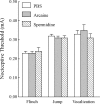Intra-amygdala administration of polyamines modulates fear conditioning in rats
- PMID: 14999084
- PMCID: PMC6730445
- DOI: 10.1523/JNEUROSCI.1622-03.2004
Intra-amygdala administration of polyamines modulates fear conditioning in rats
Abstract
Amygdalar NMDA receptor activation has been implicated in the acquisition of fear memories in rats. However, little is known about the role of endogenous modulators of the NMDA receptor, such as polyamines, in pavlovian fear-conditioning learning. Therefore, in the present study we investigated whether the immediate pretraining or post-training bilateral infusion of arcaine, an antagonist of the NMDA receptor polyamine-binding site, or spermidine, an agonist of the NMDA receptor polyamine-binding site, into the amygdala affected classical fear conditioning in rats. Bilateral microinjections of arcaine (0.0002-0.2 nmol) decreased, whereas spermidine (0.002-20 nmol) increased, contextual and auditory fear conditioning. Arcaine coadministration, at a dose that had no effect per se, reversed the facilitatory effect of spermidine. These results provide evidence that endogenous and exogenous polyamines modulate the acquisition or early consolidation (or both) of the fear-conditioning task in the amygdala.
Figures








References
-
- Anderson DJ, Crossland J, Shaw GG (1975) The actions of spermidine and spermine on the central nervous system. Neuropharmacology 14: 571-577. - PubMed
-
- Antoniadis E, McDonald RJ (2000) Amygdala, hippocampus and discriminative fear conditioning to context. Behav Brain Res 108: 1-19. - PubMed
-
- Barros DM, Izquierdo LA, Mello e Souza T, Ardenghi PG, Pereira P, Medina JH, Izquierdo I (2000) Molecular signalling pathways in the cerebral cortex are required for retrieval of one-trial avoidance learning in rats. Behav Brain Res 114: 183-192. - PubMed
-
- Cahill L, Weinberger NM, Roozendaal B, McGaugh JL (1999) Is the amygdala a locus of “conditioned fear”? Some questions and caveats. Neuron 23: 227-228. - PubMed
-
- Campeau S, Miserendino MJD, Davis M (1992) Intra-amygdala infusions of the N-methyl-d-aspartate receptor antagonist AP5 blocks acquisition but not expression of fear-potentiated startle to an auditory conditioned stimulus. Behav Neurosci 106: 569-574. - PubMed
Publication types
MeSH terms
Substances
LinkOut - more resources
Full Text Sources
